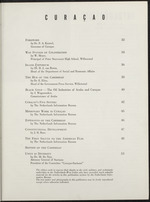| 1 |
 |
“...Colonization 34
by W. Meyer,
Principal of Peter Stuyvesant High School, Willemstad
Island Emporium 36
by Dr. H. J. van Boven,
Head of the Department of Social and Economic Affairs
The Hub of the Caribbean 38
by Dr. E. Elias,
Head of the Government Press Service, Willemstad
Black Gold — The Oil Industries of Aruba and Curagao 40
by I. Wagenmaker,
Commissioner of Aruba
Curacao’s Five Sisters 42
by The Netherlands Information Bureau
Missionary Work in Curacao 45
by The Netherlands Information Bureau
Esperanto of the Caribbean 46
by The Netherlands Information Bureau
Constitutional Development 47
by J. H. Boas
The First Salute to the American Flag 48
by The Netherlands Information Bureau
Bastion of the Caribbean
Unity in Diversity 53
by Dr. M. De Niet,
Attorney General of Surinam
President of the Committee “Curagao-Surinam”
The editors wish to express their thanks to the civil, military, and ecclesiastic
authorities in the Netherlands West Indies who have provided much valuable
material for the articles...”
|
|
| 2 |
 |
“...“ESPERANTO”
OF THE CARIBBEAN
I" IKE Surinam, the other Dutch Territory in the Western
-I—■1 Hemisphere, Curagao has a language all its own. In
Surinam it is “talkee talkee” and in Curasao it is “Papia-
mento.” Etymologically, the language of Curacao is . . .
well, there’s an argument about that.
One of the earliest students of the odd tongue was a
Father Schabel who characterized it as a “broken kind of
Spanish.” Later, another scholar termed it “Negro-Span-
ish.” An encyclopedia states it derives from “the African
language.” Still another authority speaks of its having been
adapted from “Negro-Portuguese.” And the Curagao Cham-
ber of Commerce describes it as a mixture of Dutch, Span-
ish, English, French, Portuguese and South American
Indian!
Like the fabled three blind men of Hindustan, all of the
above definitions may be considered “partly in the right,
but all were in the wrong.” True, Papiamento is just about
90 per cent derived from Spanish. But the remaining 10 per
cent is almost...”
|
|
